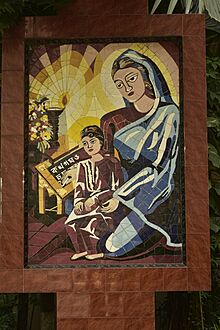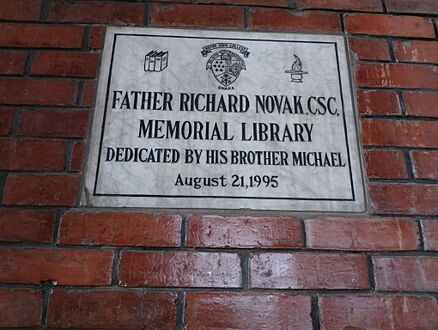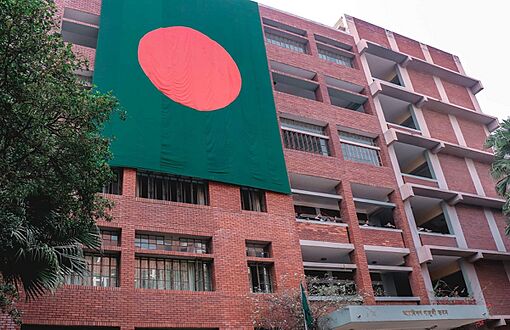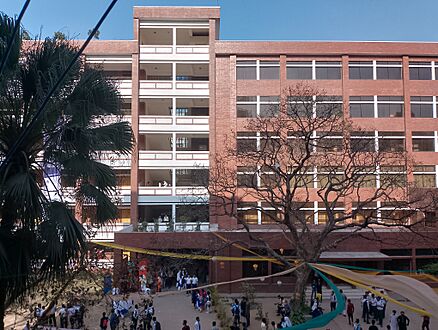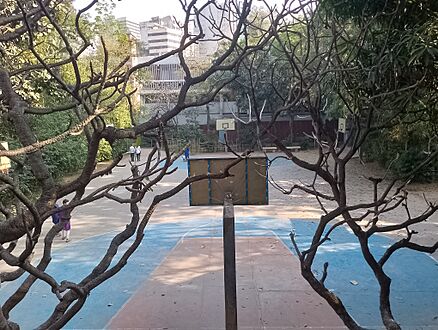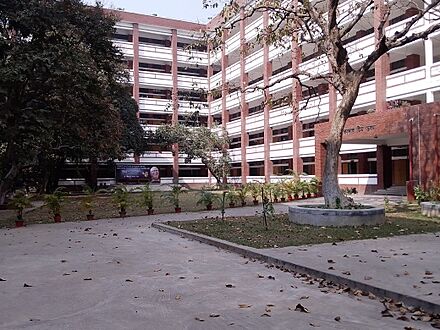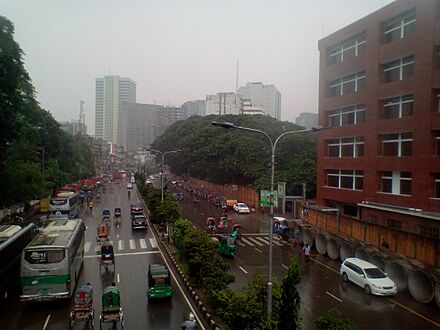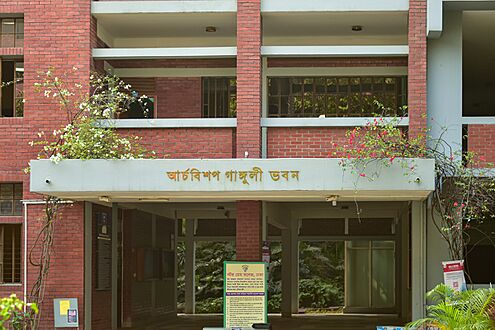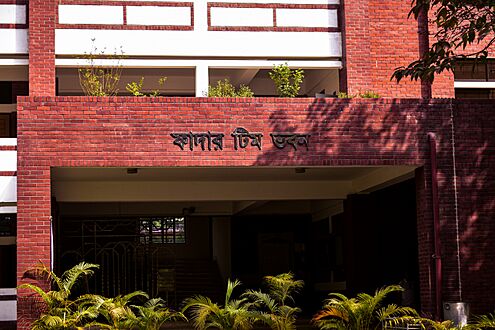Notre Dame College, Dhaka facts for kids
|
নটর ডেম কলেজ, ঢাকা
|
|
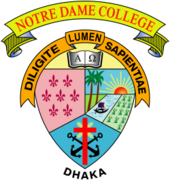
Seal of Notre Dame College
|
|
|
Other name
|
NDC |
|---|---|
|
Former name
|
St. Gregory's College |
| Motto |
Latin: Diligite Lumen Sapientiae
|
|
Motto in English
|
Love the light of wisdom |
| Type | |
| Established | 3 November 1949 |
| Accreditation | Dhaka Education Board |
| Affiliation | National University, Bangladesh |
|
Religious affiliation
|
Catholic Church (Congregation of Holy Cross) |
| Principal | Fr. Hemanto Pius Rozario, CSC (2012 – present) |
| Vice-principal | Vacant since 2025 |
| Students | 7000 (As of 2019[update]) male |
| Address |
Arambagh, Motijheel
,
,
23°43′52″N 90°25′15″E / 23.7310°N 90.4209°E |
| Campus | Urban, 5 acres (2.0 ha) |
| Language | Bangla and English |
| Demonym | Notredamian |
| Colors | Cream (shirt) Black (pant) |
 |
|
Notre Dame College, Dhaka (also known as NDC) is a well-known all-boys school in Dhaka, the capital of Bangladesh. It teaches students at the higher secondary (college) and undergraduate levels. The college is run by Catholic priests from the Congregation of Holy Cross.
The school first opened on November 3, 1949, as St. Gregory's College. It was located in an area called Laxmibazar. In 1954, it moved to its current location in Arambagh and was renamed Notre Dame College. "Notre Dame" is French for "Our Lady," a name for Mary, the mother of Jesus.
Notre Dame College is famous for its excellent education. It has been named the best college in the country multiple times. While it is a Christian school, it welcomes students from all religions and backgrounds. In fact, most of its students are Bengali Muslims. The college is one of the few in Bangladesh allowed to have its own admission test.
Contents
History of the College
How It All Started
After the partition of India in 1947, the government of what was then East Pakistan asked the Catholic Church to open new colleges. In response, the Congregation of Holy Cross started St. Gregory's College in 1949. It began with just 19 students studying Arts and Commerce.
A year later, in 1950, the college moved to a new building and became connected with the University of Dhaka. The college grew quickly. By 1951, it had 55 students. In 1954, the college moved to Arambagh and was renamed Notre Dame College. A science department was added, and the college started offering more courses, like a Bachelor of Arts (BA) degree.
By 1959, Notre Dame College was known as the best college in East Pakistan. A Bachelor of Science (B.Sc) course was added in 1960.
The Liberation War and After
The college's activities were paused during the Bangladesh Liberation War in 1971. The principal at the time was an American priest named Richard William Timm. During the war, the college building was used as a safe place by the Red Cross and the United Nations.
After the war, Father Timm and the college students helped with relief and rebuilding efforts across the new country of Bangladesh. The college also helped people during the major floods in 1973 and 1974. For his amazing service, Father Timm received the Ramon Magsaysay Award in 1987.
In 1974, Bengali became the main language for teaching, but English was brought back as an option in 1997. The college is now connected with the National University, Bangladesh.
What's in a Name?
Name and Motto
The name "Notre Dame" is French and means "Our Lady." This is a title for Mary, who is a very important figure in Christianity. The college was named in her honor.
The college's motto is in Latin: Diligite Lumen Sapientiae. This translates to "Love the light of wisdom." It encourages students to always seek knowledge and understanding.
The College Emblem
The emblem, or logo, of Notre Dame College is full of meaning.
- The Open Book: At the top, an open book shows the Greek letters Alpha (Α) and Omega (Ω). These are the first and last letters of the Greek alphabet. They represent all knowledge, from beginning to end.
- The Lotus Flowers: On the left, seven lotus flowers represent purity and the search for knowledge even in difficult times.
- The River and Fields: On the right, a river, a boat, and golden fields show the beautiful, green landscape of Bangladesh.
- The Cross and Anchors: At the bottom, a cross with two anchors is the symbol of the Congregation of Holy Cross, the group of priests who run the college. It represents hope and salvation.
Campus and Students
Students who attend Notre Dame College are called "Notredamians." Every year, the college accepts over 3,000 students in science, humanities, and business studies. The admission process is very competitive.
The campus has several buildings, including the Archbishop Ganguly Building and the Father Timm Building. It also has a library and sports facilities. An American architect named Robert Boughey designed the main building of the college.
Fun and Learning Outside the Classroom
Notre Dame College has over 30 clubs for students to join. These clubs help students explore their interests, learn new skills, and make friends.
Notre Dame Science Club
Founded in 1955 by Father Richard William Timm, this is the oldest science club in Bangladesh. It encourages students to explore science through experiments and projects.
Notre Dame Nature Study Club
This was the first nature club in the country, started in 1984. Members learn about the environment and how to protect it.
Notre Dame Rotaract Club
Started in 1990, this was the first Rotaract club at a college in Bangladesh. It focuses on community service and leadership.
Other Popular Clubs
- Notre Dame Abritti Dal: A recitation club that helps students improve their public speaking and appreciate poetry.
- Notre Dame International Understanding and Relation Club (IURC): This club helps students learn about different cultures and global issues.
- Notre Dame Writer's Club: For students who love to write stories, poems, and articles.
- Notre Dame Math Club: Organizes math festivals and helps students who are passionate about numbers.
- Notre Dame Photography Club: A place for students to learn and practice the art of photography.
- Notre Dame Information Technology Club (NDITC): Focuses on things like computer programming, robotics, and graphic design.
College Leadership
The college is run by priests from the Congregation of Holy Cross. The head of the college is called the Principal. Since it was founded, eleven priests have served as the principal. The current principal is Father Hemanto Pius Rozario, who started in 2012.
Notable Alumni
Many famous and successful people have graduated from Notre Dame College. They have become leaders in politics, science, arts, and many other fields in Bangladesh and around the world.
Gallery
See also
 In Spanish: Colegio Notre Dame (Daca) para niños
In Spanish: Colegio Notre Dame (Daca) para niños
- St. Joseph Higher Secondary School
- Holy Cross College, Dhaka
- List of colleges in Bangladesh
- Education in Bangladesh


